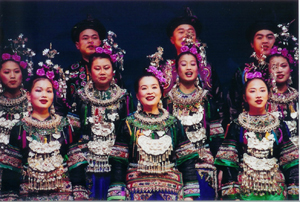 According to the Dong people in southwestern China, "The Han people, having their own autography, pass down books, while the Dong people, without an autography, pass down songs from generation to generation. Rice is food for the body, and song is food for the soul." The Dong people have never had an autography of its own, and did not have a writing system until 1958. Before that the Dong Culture, the history and stories were all recorded and handed down by means of songs. For this reason, the Dong culture, though having experienced ups and downs in history, has been well preserved and is gradually drawing attention from the world.
According to the Dong people in southwestern China, "The Han people, having their own autography, pass down books, while the Dong people, without an autography, pass down songs from generation to generation. Rice is food for the body, and song is food for the soul." The Dong people have never had an autography of its own, and did not have a writing system until 1958. Before that the Dong Culture, the history and stories were all recorded and handed down by means of songs. For this reason, the Dong culture, though having experienced ups and downs in history, has been well preserved and is gradually drawing attention from the world.
One of the ethnic minority groups of China, the Dong people are said to be the descendants of the ancient Guyue people, with a history of 2500 years. Mainly distributed in Guizhou, Hunan, Guangxi, and Hubei provinces, the Dong group has a population of 2.6 million, the majority of which is engaged in agriculture and forestry. Honest and simple, the Dong people are rich in creativity, as a folk saying goes, "The Dong culture has three treasures: drum tower, grand songs, and bridal sedan chair." Among these treasures, the grand songs are a kind of folk music special to the Dong group.
Grand songs, known as galao among the locals, are the most representative public chorus of the Dong people, and popular mainly in Liping, Rongjiang, and Congjiang of Guizhou Province, and Sanjiang in the Guangxi Zhuang Autonomous Region. Grand songs have various types, mainly: the narrative style, mainly about story plots and persona dialogues; the lyric style, mainly about love between the two genders; morality style, mainly about religious and morality expostulations; and vocalist style, mainly showing the beauty of musical melody; There are also etiquette-and-custom, drum-tower, and local opera grand songs; According to different singers, there are grand songs for a male, female, and child's voice. Well-trained choruses perform all of these songs.
Traditionally, a chorus is made up of one family and the formal performing place of grand song is the drum-tower. Usually the host group would invite visiting guests to sing in the antiphonal style. But it should be between groups of different genders, and song groups of the same gender cannot invite each other to sing. The songs may be solo or chorus, with the latter featuring multiple voice parts: alt, mediant, and bass or only alt and bass. Bass is the main part, which, while performing, lasts for a long time, lingering like the loquacious murmuring of a brook. The alt is free to express itself, imitating hundreds of birds twittering at the same time. Harmonious and prefect, grand songs have graceful melody and free rhythm, quick or slow. Sometimes, they are calm and fluent, full of sentiments, sometimes smart and bold, full of grand might, and at other times sweetly and clearly broad, echoing and attractive.
The Dong people treasures their grand songs very much, believing that songs are knowledge and that the one capable of singing a great many songs is knowledgeable. In the areas when the Dongs live, singing masters are hailed as the most intelligent and sensible, and hence are highly respected by the local people. As the most important part of the Dong songs, the graceful and plain grand songs truthfully represent the Dong people's love for life, nature, and their hometown, and vividly portrait the ethnic group's character: honesty, warm-heartedness, sincerity, and passion.
